
More Money, Less Problems—How to Maximize Business Value

Why Business Profitability Matters More Than Ever
How to increase business profitability? The answer lies in understanding that profitability isn't just about making money—it's about creating a sustainable, valuable business that works without you. Here are the core strategies:
Revenue Growth:
- Increase prices strategically
- Focus on customer retention (can boost profits 25-95%)
- Expand market reach
- Upsell and cross-sell existing customers
Cost Management:
- Negotiate better supplier terms
- Eliminate unprofitable products/services
- Reduce waste and overhead
- Optimize inventory levels
Operational Efficiency:
- Automate repetitive tasks
- Improve employee productivity
- Streamline workflows
- Improve cash flow management
Running a profitable business feels like a constant juggling act. You're managing costs, chasing revenue, and trying to keep everything running smoothly while competitors breathe down your neck. But here's the truth: profitability isn't about working harder—it's about working smarter.
The research shows clear patterns. Companies that focus on customer retention can increase profits by 25% to 95%. Meanwhile, 40% of employees who receive poor training leave within their first year, costing you up to twice their salary in replacement costs. These aren't just numbers—they're roadmaps to better profits.
The businesses that thrive aren't necessarily the ones with the highest revenue. They're the ones that understand their profit drivers, control their costs, and build systems that generate predictable results. They know that increasing profitability requires a strategic approach across three key areas: boosting revenue, cutting unnecessary costs, and streamlining operations.
I'm Keaton Kay, founder of Scale Lite, and I've spent years helping business owners in private equity, enterprise sales, and operations understand how to increase business profitability through better systems and processes. My experience ranges from working with major enterprise clients at companies like DocuSign and Tray.io to helping private equity firms optimize their portfolio companies for maximum value creation.

How to increase business profitability? word list:
- How to achieve operational excellence?
- How to drive business growth?
- How to improve customer satisfaction?
The Foundation: Understanding and Measuring Profitability
Think of profitability as your business's report card. It tells you whether all your hard work is actually paying off or if you're just spinning your wheels. How to increase business profitability? starts with understanding what profitability really means for your specific business.
Profitability isn't just about having money left over at the end of the month. It's about creating a business that consistently generates more value than it consumes. Your gross profit margin shows how much money remains after covering the direct costs of your products or services. Your net profit margin reveals what's left after paying all expenses, including rent, salaries, and that expensive coffee machine in the break room.
These numbers aren't just for impressing your accountant. They're the vital signs of your business's financial health. When you understand your margins, you can make smarter decisions about pricing, spending, and where to focus your energy for maximum impact.
Analyze Your Financials to Find Opportunities
Your financial statements are like treasure maps, showing you exactly where profit opportunities are hiding. Most business owners glance at these documents once a year during tax season, but that's like checking your car's oil only when the engine starts smoking.
Your income statement reveals the story of your revenue and expenses over time. Are your Cost of Goods Sold (COGS) creeping up without you noticing? Is that new marketing campaign actually paying for itself? This statement holds the answers.
The balance sheet gives you a snapshot of what you own versus what you owe. It's your business's financial selfie at any given moment. Meanwhile, your cash flow statement tracks the actual money moving in and out of your business. This one's crucial because you can be profitable on paper while scrambling to pay bills if customers are slow to pay.
By regularly reviewing these three documents, you'll start identifying trends before they become problems. Maybe your overhead costs are growing faster than your revenue, or perhaps certain products are more profitable than others. This Free E-Book on Finance & Accounting can help you dive deeper into understanding these financial tools.
Identify and Track Your Key Profit Drivers
Not all business activities contribute equally to your bottom line. Some are profit superstars, while others are just along for the ride. Understanding your profit drivers means identifying what actually moves the needle in your business.
Financial drivers are the obvious ones: your prices, sales volume, and costs. A small increase in your average sale price or a reduction in supplier costs can dramatically boost profitability. But here's where it gets interesting.
Non-financial drivers often have the biggest impact on your profits. Customer satisfaction directly affects repeat business and referrals. Employee morale impacts productivity and reduces costly turnover. Even your error rate ratio matters because mistakes eat into profits through wasted materials and unhappy customers.
The key is setting KPIs that track both types of drivers. If customer satisfaction is crucial for your business, measure it regularly through surveys or retention rates. If employee productivity drives profits, track output per person or project completion times. This approach to Data-Driven Decision Making helps you focus on what actually matters, not just what's easy to measure.
Create a Budget and Benchmark Your Performance
Developing a budget isn't about restricting your business; it's about giving your money a job to do. A good budget tells every dollar where to go instead of wondering where it went. The real challenge isn't creating the budget—it's sticking to a budget when opportunities and emergencies arise.
Comparing actuals to projections helps you spot problems early. If your marketing budget is 50% overspent by mid-year, you need to adjust course now, not in December. Regular budget reviews keep you on track and help you make informed decisions about where to invest and where to cut back.
Benchmarking takes this process one step further by comparing your performance to industry averages and competitors. If your operational costs are significantly higher than similar businesses, that's a red flag worth investigating. Through competitive analysis, you might find that your pricing is too low or that you're overspending in certain areas.
Setting realistic goals based on both your internal budget and external benchmarks creates a roadmap for improvement. This Data-Driven Business Strategy approach ensures you're not just guessing about what needs to change—you're making informed decisions based on solid data.

A 3-Pronged Approach: How to Increase Business Profitability?
Now that we understand the foundation, let's tackle the real question: How to increase business profitability? The answer isn't a single magic bullet—it's a strategic approach that touches every part of your business. Think of it like tuning up a car: you can't just fix the engine and ignore the brakes and transmission. Everything needs to work together.
After working with countless business owners, I've found that the most successful approach involves three interconnected strategies: boosting revenue, reducing costs, and streamlining operations. These aren't separate tasks you tackle one at a time. They work together like a three-legged stool—remove one leg, and the whole thing falls over.
The beauty of this approach is that small improvements in each area compound into significant profit gains. A 5% increase in prices, combined with a 3% reduction in costs and a 10% boost in productivity, can dramatically transform your bottom line. This comprehensive Business Growth Strategy ensures sustainable growth rather than short-term fixes.

Strategy 1: How to Increase Business Profitability by Boosting Revenue
Revenue growth is often the first thing business owners think about when they want to increase profits. But here's the thing—it's not just about selling more. It's about selling smarter. The goal is to maximize the value you extract from every customer interaction and expand your market reach strategically.
Leverage Smart Pricing and Sales Strategies
Pricing is probably the fastest lever you can pull to boost profitability. Yet most business owners are afraid to touch it. Here's the reality: if you haven't raised your prices in the last two years, you're probably leaving money on the table.
Value-based pricing changes everything. Instead of just adding a markup to your costs, price based on the value you deliver. If your HVAC repair saves a restaurant from losing thousands in spoiled food, your emergency service fee should reflect that value, not just your time and parts.
Tiered pricing gives customers options while guiding them toward higher-value purchases. Offer basic, premium, and enterprise packages. Most customers will choose the middle option, but having the premium tier makes your standard service look reasonable by comparison.
The real magic happens with upselling and cross-selling. Train your team to naturally suggest complementary services. A plumber fixing a leak might notice an aging water heater and suggest a maintenance plan. This isn't pushy sales—it's genuinely helpful service that increases your average order value.
Product bundling deserves special attention. Research by Vineet Kumar, an assistant professor at Harvard Business School, shows that offering complementary products or services together can significantly boost profits. The key is mixed bundling—offer both individual services and bundled packages. A landscaping company might bundle lawn care with seasonal cleanup services, providing convenience for customers and predictable revenue streams. You can read more about his research here: Better by the Bundle.
Limited-time promotions create urgency, but use them strategically. You don't want to train customers to only buy when you're running a sale. These strategies form the backbone of How to Drive Business Growth.
Focus on Customer Retention and Satisfaction
Here's a statistic that should grab your attention: Frederick Reichheld, a business strategist and author whose research at Bain & Company revealed that increasing customer retention by just 5% can increase profits by 25% to 95%. That's not a typo—it's the power of keeping the customers you already have.
Think about it from a cost perspective. You've already invested in acquiring these customers. They know your quality, trust your service, and understand your value. Loyal customers become your best salespeople, referring friends and family without you spending a dime on advertising.
Personalized experiences don't require fancy technology. It's as simple as remembering a customer's preferences or following up after a service call. Seeking feedback shows you care about their experience and gives you valuable insights for improvement. After-sales service turns a one-time transaction into an ongoing relationship.
Loyalty programs work especially well for service businesses. A pest control company might offer discounts for annual contracts, while a cleaning service could provide a free deep clean after twelve regular visits. The goal is making it more valuable for customers to stay than to leave. Learn more about How to Improve Customer Satisfaction.
Expand Your Market and Diversify Offerings
Growth means looking beyond your current customer base, but it should be strategic, not random. Market research helps you identify underserved segments or geographic areas where demand exceeds supply. Maybe your electrical services are popular with residential customers, but commercial clients in your area are underserved.
Targeting new demographics might mean adjusting your marketing message rather than changing your services. The same roofing company can appeal to young homeowners worried about energy efficiency and older homeowners focused on maintenance and reliability.
Geographic expansion is often the most straightforward growth strategy. If you're successful in one town, neighboring communities might offer similar opportunities. Developing new product lines should complement your existing expertise—a successful painter might add pressure washing or deck staining services.
Sometimes the opportunity lies in repositioning your brand. You might find that your "budget-friendly" service actually delivers premium value, allowing you to raise prices and target higher-end customers. Repositioning your brand can open up entirely new profit margins.
Strategy 2: Trim the Fat by Reducing Business Costs
Cost reduction gets a bad reputation because people think it means cutting quality or laying off employees. Smart cost management is different—it's about eliminating waste and inefficiency while maintaining or improving your service quality. As Inc. magazine notes, you want to trim the fat, but you don't want to overdo it or sacrifice what makes your business valuable.
Optimize Inventory and Supplier Relationships
For businesses dealing with parts, materials, or supplies, inventory management can make or break profitability. Just-in-time inventory means keeping inventory levels as low as possible while still meeting customer demand. This isn't about running out of critical supplies—it's about not tying up cash in excess stock.
Eliminating obsolete stock frees up storage space and capital. That old equipment gathering dust represents money that could be working elsewhere in your business. Even selling it at a loss might be better than letting it continue depreciating.
Negotiating supplier terms isn't just about lower prices. You might secure longer payment terms, bulk purchasing discounts, or priority service during busy seasons. Consolidating suppliers can increase your purchasing power and simplify your procurement process. Instead of dealing with five different vendors, working with two or three can lead to better relationships and better deals. There are many proven Ways to reduce inventory costs that don't compromise service quality.
Eliminate Unprofitable Activities and Reduce Waste
Every business has activities that consume resources without contributing meaningfully to profit. The Pareto Principle (80/20 rule) often applies here—80% of your profit probably comes from 20% of your services or customers. The trick is identifying which 20% deserves your focus and which 20% might be dragging you down.
Analyzing product and service profitability means looking beyond gross revenue. That popular service that keeps you busy might actually be losing money when you factor in labor, materials, and overhead costs. Sometimes the solution is raising prices, other times it's streamlining the process, and occasionally it means saying goodbye to unprofitable offerings.
Lean principles focus on finding and removing steps in your process that don't add value. This might mean reducing redundant paperwork, eliminating unnecessary approvals, or streamlining your workflow. Reducing material waste saves money and often improves your environmental impact—a win-win for your bottom line and your brand.
Cutting unnecessary overhead requires regular review of all recurring expenses. Unused software subscriptions, oversized office space, and inefficient equipment all drain profits. As Kabbage points out, Responsible waste management not only cuts costs but can improve your brand reputation and customer perception.
Strategy 3: How to Increase Business Profitability by Streamlining Operations
Operational efficiency is where the real magic happens. When your business runs smoothly, costs naturally decrease, customer satisfaction improves, and you create capacity for growth without proportional increases in overhead. This is the foundation of How to Improve Business Performance.

Boost Employee Engagement and Productivity
Your employees are your greatest asset, and their productivity directly impacts your bottom line. Here's a sobering statistic: 40% of employees who receive poor training leave their jobs within the first year. Given that the Cost of replacing an employee can range from one-half to two times their annual salary, investing in employee training isn't just nice to have—it's essential for profitability.
Well-trained employees make fewer mistakes, work more efficiently, and provide better customer service. Recognition programs don't have to be expensive—sometimes acknowledging good work publicly or offering small rewards can significantly boost morale and productivity.
Soliciting feedback from your team often uncovers valuable insights about operational inefficiencies. Your technicians might know shortcuts that save time, or your office staff might identify recurring customer complaints that could be prevented. Reducing employee turnover through better engagement pays dividends. According to Gallup research on employee engagement, while engagement rates are improving, 13% of workers still report feeling actively disengaged, representing untapped productivity potential.
Accept Technology and Automation
For many blue-collar service businesses, technology feels intimidating or unnecessary. But embracing technology and automation isn't about replacing people—it's about using digital tools to make your business run more smoothly and freeing your team to focus on high-value activities.
Automating repetitive tasks like scheduling appointments, sending invoices, or managing customer follow-ups eliminates human error and saves time. Customer relationship management (CRM) principles help you organize customer information, track interactions, and identify sales opportunities without complex systems.
Data analytics sounds fancy, but it's really about using information to make better decisions. Understanding your busiest seasons, most profitable services, or most efficient routes helps you optimize everything from staffing to inventory. Digital change simply means using digital tools strategically to streamline operations.
These improvements lead to significant gains in Business Process Streamlining and can open up powerful AI-Driven Workflow Automation opportunities.
Improve Cash Flow Management
Even profitable businesses can fail if they run out of cash. Effective cash flow management ensures you have the working capital to operate and grow. Managing accounts receivable means implementing clear invoicing procedures, sending timely reminders, and following up on overdue payments. Consider requiring deposits for larger jobs or offering early payment discounts.
Negotiating payment terms works both ways—while you want favorable terms from suppliers, you can also structure customer payments to improve your cash flow. Cash flow forecasting helps you anticipate potential shortfalls and take proactive measures like securing credit lines or adjusting payment schedules.
Ensuring sufficient working capital provides a buffer against unexpected expenses or revenue dips. This financial cushion allows you to take advantage of opportunities and weather temporary setbacks. These practices form the foundation of Operational Excellence Strategies.
Frequently Asked Questions about Increasing Business Profitability
Let me address the most common questions I hear from business owners who want to understand how to increase business profitability. These questions come up in almost every conversation I have with entrepreneurs who are ready to take their operations to the next level.
What is the fastest way to increase profitability?
The fastest results usually come from a two-pronged approach that hits your biggest impact areas immediately. First, strategically increase prices on your most popular or high-demand offerings. Many business owners are surprised to find they can raise prices by 10-15% without losing customers, especially when they're providing excellent value.
Second, conduct a rapid expense audit of your three largest cost categories. Look for cuts that won't hurt your quality or customer experience. Maybe you're paying for software you don't use, or you could negotiate better terms with your biggest supplier. These quick wins often deliver immediate results within 30-60 days.
The key word here is "strategically." Don't just slash prices or cut expenses randomly. Focus on areas where small changes create big impacts on your bottom line.
How is profitability different from profit?
Think of profit as the dollar amount you have left over after paying all your bills. If you made $500,000 in revenue and had $450,000 in expenses, your profit is $50,000. It's a concrete number you can put in the bank.
Profitability is about efficiency - it's usually expressed as a percentage that shows how good you are at turning sales into actual money you keep. Using the same example, your profit margin would be 10% ($50,000 divided by $500,000).
A highly profitable company is like a skilled chef who can create amazing meals without wasting ingredients. They're experts at maximizing their earnings from every sale. You might have two companies with the same $50,000 profit, but if one achieved it with $250,000 in revenue and the other needed $500,000, the first company is far more profitable and efficient.
Can a business be profitable but still have cash flow problems?
Absolutely, and this catches many business owners off guard. It's one of the most frustrating situations you can face as an entrepreneur. Your profit and loss statement looks great on paper, showing healthy margins and strong sales, but your bank account tells a different story.
This usually happens when customers are slow to pay their invoices. You've done the work, sent the bill, and recorded the sale as revenue, but the actual cash is still sitting in someone else's account. Meanwhile, you still need to pay your team, suppliers, and rent with real money, not promises.
Large upfront expenses can also create this problem. Maybe you bought new equipment or had to purchase materials for a big project before getting paid. Your business is profitable in the long run, but the timing of cash in versus cash out creates temporary shortages.
This is why cash flow management is so critical. It's not enough to be profitable - you need to actively manage when money comes in and goes out to keep your business running smoothly.
Turn Profitability into a Predictable Outcome
How to increase business profitability? The answer isn't found in a single magic bullet or overnight change. It's finded through a commitment to continuous improvement and strategic thinking that transforms your business from a constant struggle into a well-oiled, predictable profit machine.
Think of profitability like building physical fitness. You don't get strong by lifting weights once; you build strength through consistent, strategic effort over time. The same principle applies to your business. By systematically boosting revenue through smarter pricing and customer retention, reducing costs through waste elimination and better supplier relationships, and streamlining operations through technology and improved workflows, you're building the business equivalent of muscle memory.
The businesses that thrive long-term aren't the ones that got lucky with one big contract or stumbled into success. They're the ones that built systems, processes, and strategies that generate predictable outcomes. They know their numbers, understand their profit drivers, and have created operations that run smoothly whether they're there every day or taking a well-deserved vacation.
Maximizing business value isn't just about the money in your bank account today—it's about creating something sustainable, scalable, and valuable. When you implement the strategies we've covered, you're not just improving this quarter's numbers; you're building a business that becomes more valuable over time, one that could eventually run without your constant oversight.
At Scale Lite Solutions, we've seen how blue-collar service businesses and companies in traditional industries can transform their operations and open up incredible growth potential. Our holistic approach combines the strategic thinking you need with the practical tools that make it happen. We believe every business owner deserves to become a Hands-Off Business Owner—someone who has built systems so effective that the business thrives with or without their daily involvement.
The path to sustainable profitability starts with a single step, but it continues with strategic execution and the right support systems. Ready to modernize your operations and open up your business's true profit potential? Explore our AI and automation solutions to see how we can help turn your profitability goals into predictable, measurable results.







